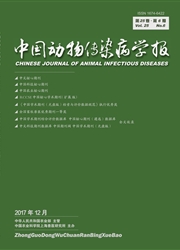

 中文摘要:
中文摘要:
为建立一种检测兔出血症病毒(Rabbit hemorrhagic disease virus,RHDV)抗体的间接ELISA方法,首先扩增了VP60的优势抗原区A(31~250 aa)和B(470~579 aa)两个片段,然后应用融合PCR方法将A、B片段连接起来,克隆至pET-30a(+),转染BL21感受态细胞,进行原核表达。用Western blot方法对表达产物(AB)的免疫原性进行鉴定,再以纯化的AB为诊断抗原,通过对抗原-抗体反应条件的多重优化,建立检测RHDV抗体的间接ELISA方法。试验结果表明,本研究成功表达了RHDV VP60的优势抗原区(AB),重组蛋白的分子量约为36 kDa,该蛋白能与RHDV抗体发生特异性反应。以纯化的AB为包被抗原,成功建立了检测RHDV抗体的间接ELISA方法。经过对部分田间样品的检测和应用,证明该方法具有特异性强、重复性好、敏感性高等优点。本研究为将来开展RHDV的流行病学调查和疫苗研究等提供了良好的技术手段。
 英文摘要:
英文摘要:
Two dominant antigen regions of VP60 capsid protein of Rabbit hemorrhagic disease virus (RHDV) were expressed in E. coli and used to develop an indirect enzyme linked immunosorbent assay (ELISA) for detection of serum antibodies. The dominant antigen regions A (31-250 aa) and B (470-579 aa) were amplified in overlapping PCR and sub-cloned to pET-30a(+) for transfection into BL21cells. The fusion protein AB was detected in inclusion bodies and visualized as a protein band with apparent molecular mass of 36 kDa in Western blot. The purified recombinant protein was then used as coating antigen to develop an indirect ELISA and reaction conditions were optimized. Preliminary application to clinical serum samples demonstrated repeatability, sensitivity and specificity of the ELISA method developed here, which could be used for epidemiological surveillance and vaccine development of RHDV.
 同期刊论文项目
同期刊论文项目
 同项目期刊论文
同项目期刊论文
 期刊信息
期刊信息
